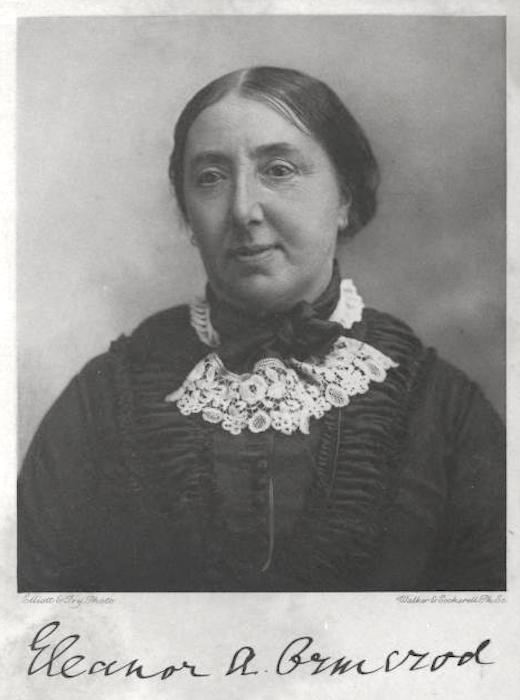
Frontispiece to the autobiography,
from an Elliott and Fry photograph.
Eleanor Ormerod (1828-1901) pioneered the science of economic entomology, or the effects of insects on the productivity of farms. Born at Sedbury Park, a mansion on a considerable family estate in Gloucestershire, Ormerod was exposed to the problems of farming and crop management from an early age. She is generally described as self-taught, and indeed, she taught herself modern languages and Latin. But her home-schooling was exceptional, and came with two unusual advantages. One was that her mother was herself a talented botanical artist, and that when they stayed in London, Eleanor and her sister Georgiana took lessons from the Pre-Raphaelite painter William Holman Hunt (Autobiography, 16); the other was that two of her seven brothers went in for medicine, one of them preparing for a career as an anatomist and surgeon. As a result, she had ready access to a microscope and scientific literature, and describes in her autobiography how she learned, early on, to prepare specimens for close examination (54). However, she brought to the table her own particular fascination with insect life, and her own quiet but unshakable confidence in the evidence of her own eyes. She was the youngest of all the children in her family, and (as she remembers) was once set to amuse herself independently while the rest were otherwise occupied:
My first insect observation I remember perfectly. It was typical of many others since. I was quite right, absolutely and demonstrably right, but I was above my audience and fared accordingly. One day while the family were engaged watching the letting out of a pond, or some similar matter, I was perched on a chair, and given to watch, to keep me quiet at home, a tumbler of water with about half-a-dozen great water grubs in it. One of them had been much injured and his companions proceeded quite to demolish him. I was exceedingly interested, and when the family came home gave them the results of my observations, which were entirely disbelieved. Arguing was not permitted, so I said nothing (as far as I remember); but I had made my first step in Entomology. [Autobiography, 2]
In 1852, when Ormerod acquired her treasured copy of James Francis Stephens's Manual of British Coleoptera, or Beetles (1839), her path was settled: she embarked on a serious and detailed study of insects, becoming a pioneer in a new science which, remarkably enough, she herself largely created: economic entomology. That is, she studied how insects affect farming production, whether for good or ill.
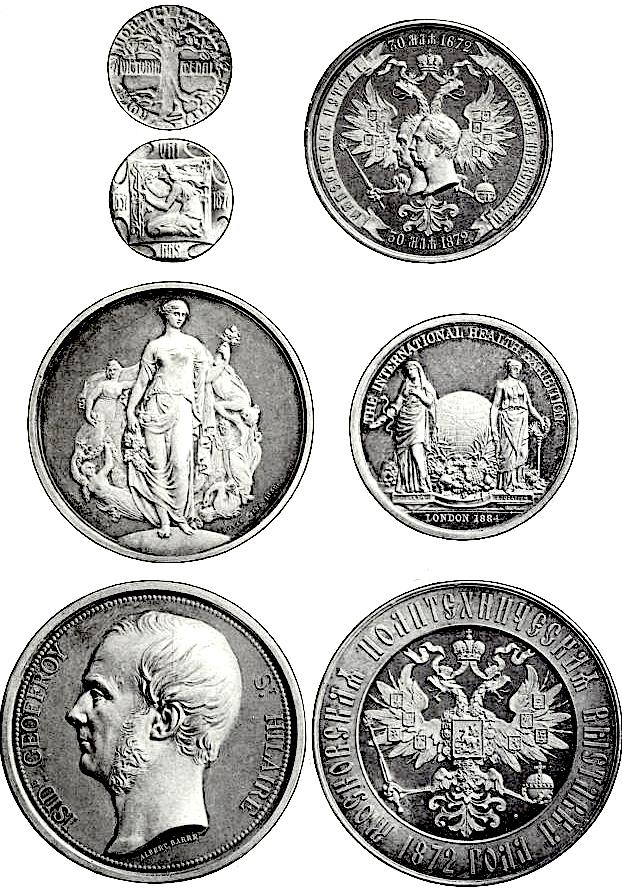
Various medals awarded to Ormerod: the Flora Medal is the second
on the left (Source: Ormerod, Autobiography, Plate XXII, facing p.98).
There were hurdles to overcome — among them, how to kill her specimens humanely, without prolonged suffering (she duly supplied herself with chloroform). By 1868 she was in a position to write to the Royal Horticultural Society and suggest a project: with the Society's encouragement, she then compiled a collection of insects which were either useful or harmful to farmers. For this she was awarded the Flora Medal in 1870, the first of many such accolades. In another development, she sent models of the harmful insects to an exhibition in Moscow in 1872; and in 1873, after her father died, she and her sister and closest companion, Georgiana, lived in Torquay for a while, then moved to Isleworth in London, not far from the then director of Kew Gardens, Joseph Hooker. She had more freedom now to make her mark in the world, and expanded her interests a little, recording weather observations for the Gardens. Although this remained subsidiary to her entomological studies, in 1878 she became the first woman to be elected as a fellow of the Meteorological Society.
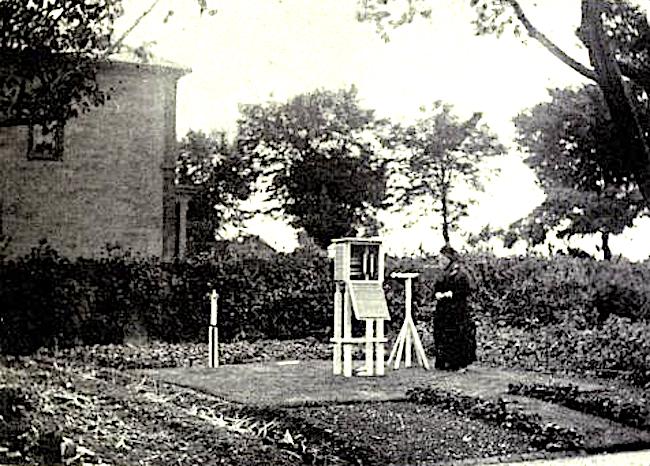
"Miss Ormerod at her Meteorological Observation Station, near Isleworth." (Source: Ormerod, Autobiography Plate XX, facing p. 80).
Still unsalaried, she was now nevertheless very much a part of the international scientific community, publishing her Annual Report of Observations of Injurious Insects from 1877 right through until 1900. According to J. F. M. Clark, these "established Ormerod as Britain's de facto government entomologist" (np). She clearly relished the role, printing and distributing many pamphlets, asking only for postage; and gave talks such as the one on 2 April 1879, entitled "Observations of the Effects of Low Temperatures on Larvæ." She also produced two substantial, authoritative and well-illustrated works on insect pests and their management: A Manual of Injurious Insects, with Methods of Prevention and Remedy (1881), and Handbook of Insects Injurious to Orchard and Bush Fruits, with Means of Prevention and Remedy (1898). By this time, Ormerod and her sister were living in St Alban's in Hertfordshire, in what was to be her last residence.
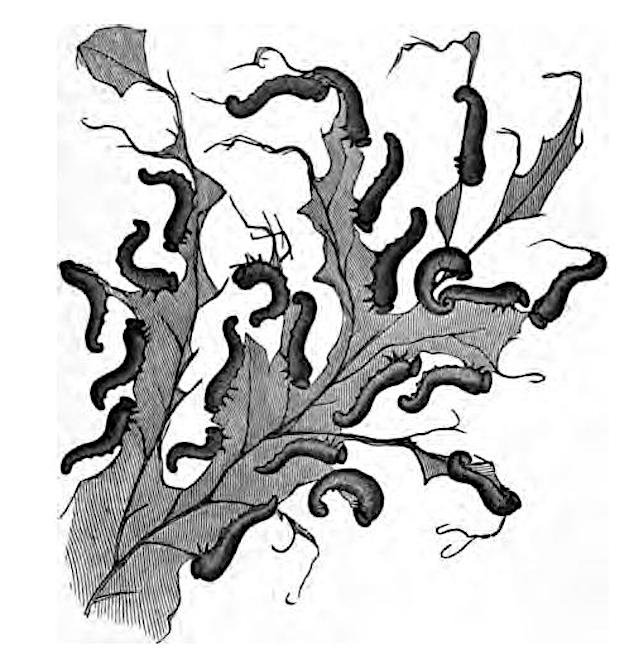
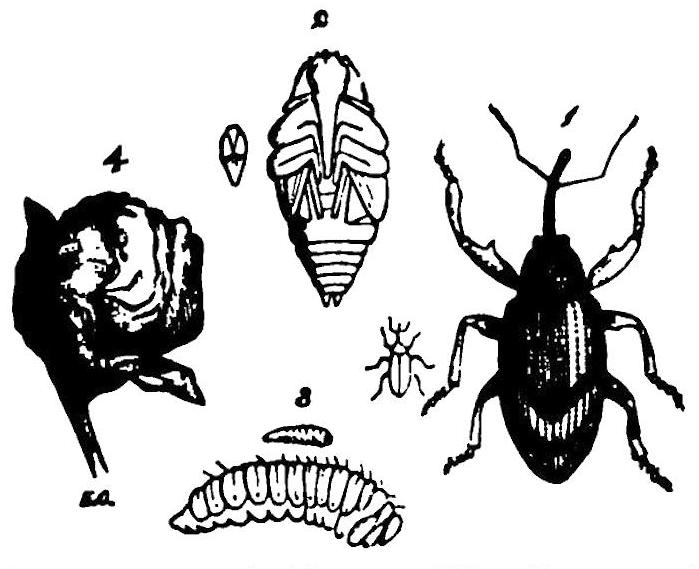
Two illustrations from Ormerod's Guide to Methods of Insect Life. Left: "Sawfly caterpillars destroying Turnip-leaf," p. 13. Right: "Apple-blossom Weevil, maggot and pupa; nat. size and mag.," p. 78.
Ormerod lectured on her entomological subjects in the 1880s: from October 1881 to June 1884, she gave six lectures at the Royal Agricultural College, Cirencester, and in 1883 she gave ten lectures at the South Kensington's Institute of Agriculture. The latter effort resulted in the publication of her Guide to the Methods of Insect Life (1884), which came out as a Text-Book of Agricultural Entomology in 1892, at the end of her period as honorary consulting entomologist to the Royal Agricultural Society. In the preface she gratefully acknowledged a variety of sources for her illustrations, but some are by her own hand, and a small "EO" can be seen beside them. A great believer in visual aids, she had lamented in her autobiography that none were offered in Stephens's trusty Manual of British Coleoptera (see p. 53).
One of the many ways in which Ormerod was ahead of her time was in advocating natural remedies for infestations, for instance, by encouraging bird life, although unfortunately she was convinced that the sparrow population did more harm than good ("The mischief that is done by the Sparrows is easily observable") and that they should be controlled (see "The House-Sparrow" 1). In this she was at odds with the ornithologist Francis Orpen Morris, who had campaigned vigorously on behalf of this very bird. It needs to be said too that along with natural remedies she also advocated the use of certain insecticides now known to be harmful, writing on one occasion, with reference to moth-caterpillar infestations, "Washing with Paris-green or London-purple [both containing arsenic], or kerosene emulsion, would be the right kind of thing" (Autobiography, 121).
By 1898 Ormerod was so well established that Edinburgh University recommended her for the post of lecturer in agricultural entomology. She would have been eminently suited to to it, but women were not yet seriously considered for such positions. Still, she served as examiner in agricultural entomology there, and was awarded an honorary LLD by the university in 1900 — a noteworthy accolade, since it was their first such honorary degree for a woman.
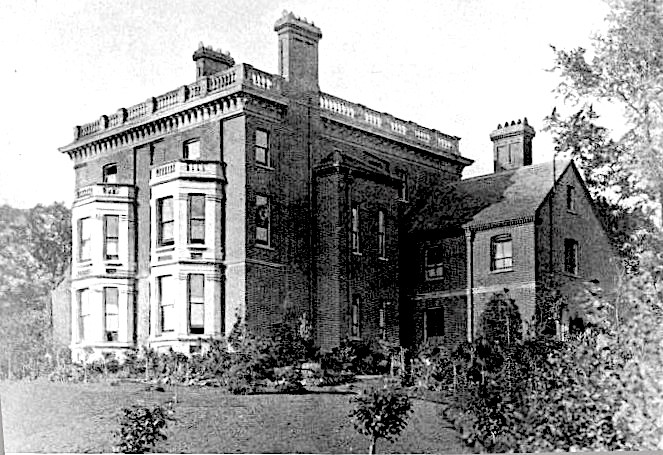
"Torrington House, St Alban's, Hants, Miss Ormerod's last residence." Autobiography Plate XIX, facing p. 74.
As a woman in a professional scientific environment at this time, Ormerod inevitably faced various difficulties, and felt that she did not always get full credit for her findings and advice. In giving up her consultancy for the Royal Agricultural Society, for instance, she explained, "My own work has steadily increased to such an extent that, with this sort of underground (unacknowledged) Government work in addition, I did not feel able to do full justice to it, and especially I wanted more time for experiment and correspondence" (Autobiography, 202). The word "unacknowledged," slipped in here in brackets, speaks volumes. Yet it is widely agreed that Ormerod was "a prime mover in making economic entomology an important specialty within biology and agricultural science" (Millar et al. 277). As another science historian puts it, "She waged war most successfully against the ox-warble fly, but tackled with equal vigour insect pests of farm, forest, garden and orchard.... Agricultural societies throughout the world honoured her for helping farmers to improve their crop yields and keep their stock healthy" — and thus to "help feed the growing population of the modern world" (Clarke 23).
Note: The study of natural history, in general, was a popular pursuit in the Victorian period, Botany, in particular, was very much a feminine hobby until it developed into a specialised discipline, when men began to "elbow, or edge, women out" (Shteir 235). Entomology, although never as much the province of women, followed something of the same trajectory. Some Victorian women did take it up. A notable example is Maria Catlow (active ca. 1840-1874), whose highly illustrated Popular Entymology, containing a familiar and technical description of the insects most common to the British Isles of 1852 helped to popularise the subject. But other women, like the Irish naturalist Mary Ball (1812-1898), preferred simply to communicate their findings to male friends (see Ogilvie and Harvey 74). Significantly, at the very end of the Victorian period, Ormerod's obituarist in the journal Nature felt the need to defend her interest in insects, assuring its readers that she had "met the standards of femininity appropriate to her social station in life" (see Sheffield 140).
Links to Related Material
- The Victorians and Animals, III: Studying Animals
- Victorian Natural History Museums and the Display of Knowledge
- Examples of entomological illustrations by John Obadiah Westwood
Bibliography
Clark, J. F. M. "Ormerod, Eleanor Anne (1828–1901), economic entomologist." Oxford Dictionary of National Biography. Online edition. Web. 17 May 2023.
Clarke, Brenda. Women and Science. Hove, Sussex: Wayland, 1989.
Millar, David, Ian Millar, John Millar and Margaret Millar, eds. The Cambridge Dictionary of Scientists. 2nd ed. Cambridge: Cambridge University Press, 2002.
Ogilvie, Marilyn Bailey, and Joy Dorothy Harvey. The Biographical Dictionary of Women in Science: Pioneering Lives from Ancient Times to the Mid-20th Century. New York and London: Routledge, 2000.
Ormerod, Eleanor A. Eleanor Ormerod, LL,D., Economic Entomologist, Autobiography and Correspondence. Ed. Robert Wallace. New York: Dutton, 1904. Internet Archive. From the University of California Libraries. Web. 17 May 2023.
_____. Guide to Methods of Insect Life and Prevention and Remedy of Insect Ravage. London: Simpkin, Marshall & Co., 1884. Internet Archive. From the collection of Oxford University. Web. 17 May 2023.
_____. "Observations of the Effects of Low Temperatures on Larvœ." Transactions of the Royal Entomological Society of London. July 1879 — II. Internet Archive. Digitizing sponsor: Biostor. Web. 17 May 2023.
_____, and W. B. Tegetmeier. The House-Sparrow. Pamphlet, self-published, August 1897. Internet Archive. From the collection of Harvard University. Museum of Comparative Zoology, Ernst Mayer Library. Web. 17 May 2023.
Sheffield, Suzanne Le-May. Revealing New Worlds: Three Victorian Women Naturalists. London and New York: Routledge, 2001.
Shteir, Ann B. Cultivating Women, Cultivating Science: Flora's Daughters and Botany in England, 1760 to 1860. Baltimore, Johns Hopkins University Press, 1996.
Created 17 May 2023